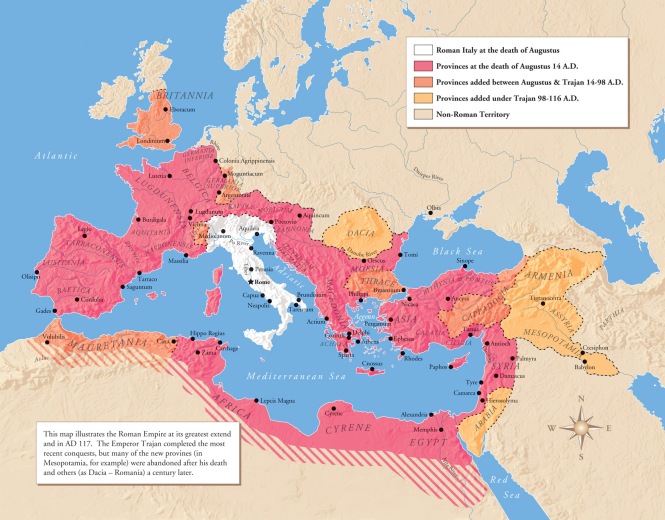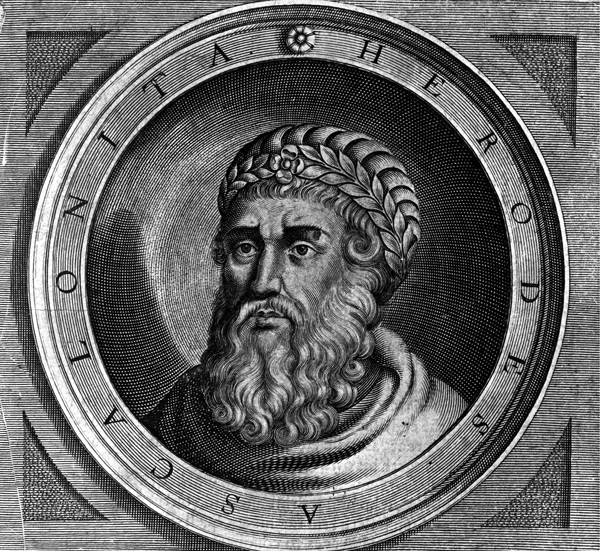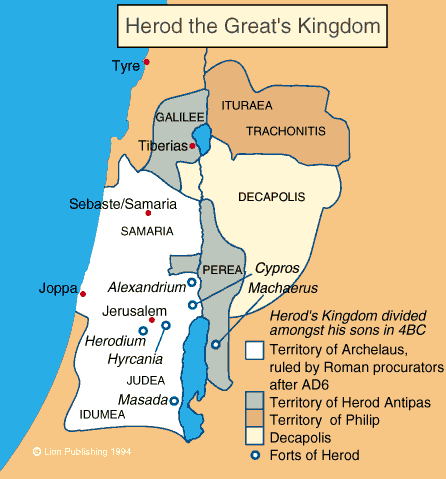Intro to the Roman Period

The Roman Period lasted from 63 BC to AD 135, beginning after the domination of Palestine. The height of the Roman Empire was during the year 117 AD, due to the impressive political and social structure that the Romans had acquired. the course of the Roman Period, many different dynasties and leaders such as Nero, Augustus Caeser, and Trajan ruled, quite often ending in tragedy and power struggles. Overall, the Roman Empire influenced almost every aspect of the surrounding Mediterranean culture. (Joshua J. Mark, http://www.ancient.eu/Roman_Empire/)
A man by the name of Hyrcanus II was chosen as high priest in the first century BC, while his advisor, Antipater, seemed to have most of the power behind the scenes, eventually becoming governor of Judea. Antipater was killed after being in power for approximately twenty years, leaving behind two sons, one of whom would eventually be called “Herod the Great”. Herod became king of Judea after his father and brother died, which lead him to end the Hasmonean dynasty along with his powerful army. This would serve as the official beginning of the Herodian dynasty. (Strauss, 104)

Herod “the Great”
Ruling from 37-4 BC, Herod “the Great”, was known as a force to be reckoned with. Not only was he a powerful leader, but he was also considered to be “a mix of a clever and efficient ruler and a cruel tyrant.” (Strauss, 105) His political strategies were ruthless as he feared any opposition or conspiracy, eventually executing his mother-in-law, two of his wives, and three sons for fear of conspiracy and to prove his authority. The Roman emperor Augustus once said of him that he would rather be his pig than his son (Strauss 105). Also, this is the same Herod that ordered the massacre of infants in Bethlehem during the time of Jesus. Surprisingly, there was some positive sides to Herod’s time of rule. He was known as a protector of Judaism, a great builder, and helped Judea prosper economically (Strauss 105-107).
The Herodian Dynasty

After Herod the Great died from intestinal cancer in 4 BC, Caesar Augustus (the supreme military leader at the time) divided the kingdom among three of Herod’s sons: Archelaus, Herod Antipas, and Herod Philip. Archelaus became ethnarch (main political leader) of Judea, Samaria, and Idumea, but was later on removed from office in AD 6 due to oppressive and erratic behavior. Judea and Samaria were then under the control of Roman governors (prefects and procurators) (Strauss 108). Herod Antipas became tetrarch (minor leader) of Galilee and Perea until he was forcefully removed by the emperor Caligula in AD 39 (Strauss 108). Lastly, Herod Philip became tetrarch of Iturea, Trachonitis, Gaulanitis, Auranitis, and Batanea. He ended up dying in AD 34, and his territory became a part of the Roman Province of Syria (Strauss 110). Other leaders who were descendants of Herod the Great include Herod Agrippa I, and Herod Agrippa II (Strauss 110).
Roman Rule and the Pax Romana
“Roman Peace”
For the first time the entire Mediterranean Region had political stability. This was thanks to the emperor Augustus and the Roman occupation. Augustus and the Romans built roads and allowed relative freedom of travel. These circumstances aided the spread of Christianity along with the Roman system of law and order which gave Christians a level of security and protection as they traveled spreading the gospel. (Strauss, 110)
This “peace” that the Romans enforced came by the ruthless suppression of revolt. The Roman provinces were reorganized into two types; senatorial and imperial. Senatorial provinces governed by proconsuls were usually loyal and peaceful territories, whereas Imperial provinces who were governed by legates were home to the Roman legions, a strong military presence. (Strauss 111-112)

Judea, which eventually turned into an imperial province, was ruled by Roman Governors. In order to maintain stability during various festivals these governors would come into town for a short period of time. This is why Pontius Pilate was in Jerusalem during Jesus’ trial. Most of these Roman Governors were insensitive towards the Jews, especially Pilate who governed Judea from AD 26-36. (Strauss 113)
In order to maintain the vast Roman Empire, they imposed a variety of taxes. The collection of these taxes became corrupted and the hatred for tax collectors became wide-spread. That is why it was significant for Jesus to spend time with these tax collectors showcasing his identification with the sinners and outcasts of Israel. (Strauss 113)

Caesar Augustus/Octavian (30 BC-AD 14)
During his 40 year reign the Roman Empire doubled. Augustus inaugurated the Pax Romana (“Roman Peace”): A time of peace and stability throughout the mediterranean region. Augustus is associated with the Census in Luke 2:1 during Jesus’ time
Tiberius (AD 14-37)
Tiberius was emperor during Jesus’ public ministry (Luke 3:1). Jesus referred to him in Mark 12:17 when he said “Give to Caesar what is Caesar’s and to God what is God’s”
Caligula (AD 37-41)
Provoked a crisis among the Jews by demanding that his image be set up in the Jerusalem temple. Agrippa I eventually convinced Caligula to  cancel the order, and the emperor was assassinated before it was carried out. Paul could have been talking about these events in 2 Thess. 2:4 when he speaks of the “man of lawlessness” who “sets himself up in God’s temple, proclaiming himself to be God”.
cancel the order, and the emperor was assassinated before it was carried out. Paul could have been talking about these events in 2 Thess. 2:4 when he speaks of the “man of lawlessness” who “sets himself up in God’s temple, proclaiming himself to be God”.
Claudius (AD 41-54)
Expelled the Jews from Rome in AD 49, most likely because of conflicts with Jewish Christians (Suetonius, Life of Claudius 25.4). Priscilla and Aquila came from Rome to Corinth at this time (Acts 18:2 and 11:28)
Nero (AD 54-68)
 Was the Caesar to whom Paul appealed during his trial in Acts 25:10 and 28:19. Later in AD 64, Nero began the first major persecution against Christians, blaming them for a fire he was rumored to have set in Rome. Both Paul and Peter were probably martyred under Nero
Was the Caesar to whom Paul appealed during his trial in Acts 25:10 and 28:19. Later in AD 64, Nero began the first major persecution against Christians, blaming them for a fire he was rumored to have set in Rome. Both Paul and Peter were probably martyred under Nero
Vespasian (AD 69-79)
He was declared emperor while in Israel putting down the Jewish Revolt of AD 66-73. He returned to Rome, leaving his son Titus to co mplete the destruction of Jerusalem and the temple.
mplete the destruction of Jerusalem and the temple.
Domitian (AD 81-96)
Was the second emperor (after Nero) to persecute the church. This persecution is likely the background to the book of Revelation.